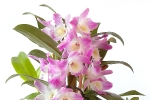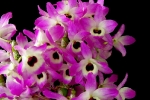Dendrobium forms the largest group of orchids, containing more than 1,500 species and probably thousands of hybrids.They are widespread in eastern and tropical Asia to Australia. Dendrobium orchid’s dimensions vary widely – some are smaller than a matchbox, while others are robust specimens, measuring more than 1 meter in height.
Like most orchids, Dendrobiums are epiphytic plants that need more light and air circulation.

Some have pseudo bulbs, roots and some others have only joined them, like wicker.
Due to the complexity of this type of orchid, some varieties can flourish not at all difficult when they are grown as houseplants.
Orchid stems can be 60 cm higher and may even have more than 20 flowers. It takes between 6-8 weeks and is excellent as cut flowers. Their colors include almost all the rainbow colors – pink, lavender, red, yellow, orange and many combinations. Orchids of lavender or white color appear in abundance on plants which are well developed and very resistant in time; they are part of a group of prolific and they frequently appear directly on the stem.
After each shoot has produced several aerial roots, it can be separated from the mother plant and plant separately; the shoots will bloom more often after one year.
Although the color palette is varied, most of Dendrobiums orchid hybrids found in stores have usually the color of lavender, white, golden-yellow or combinations of these colors.
Some of the more unusual species and even particular hybrids can be blue, ivory, orange or red or vibrant can have exotic designs. Most orchids are not fragrant perennial, although deciduous species may have fragrance of citrus and gooseberry.
Dendrobium needs bright light; the soil should be allowed to dry slightly between watering when the orchid is in flower.
The plant prefers well-ventilated compost. Regardless of the compost used, it should be airy, light and not to gather around the roots.
Dendrobium orchid roots do not tolerate wet soil, soaked with water. This situation inevitably leads to root rot.
As a tip, you should spray the foliage with water only occasionally to help the maintenance of the moisture, especially in hot days.
Orchids withstand temperatures of 7-35 C, ideally somewhere between 16 and 30 C.
Changing the orchid pot is made once at every two years, in spring, after blooming.
Use a mixture of 10 parts of finely ground bark and 1 part of compost for orchids, for smaller pots.
The plant can be treated with fertilizer, the whole year, at a concentration of 1 teaspoon per 3.8 liters.
Dendrobium Pictures Gallery



